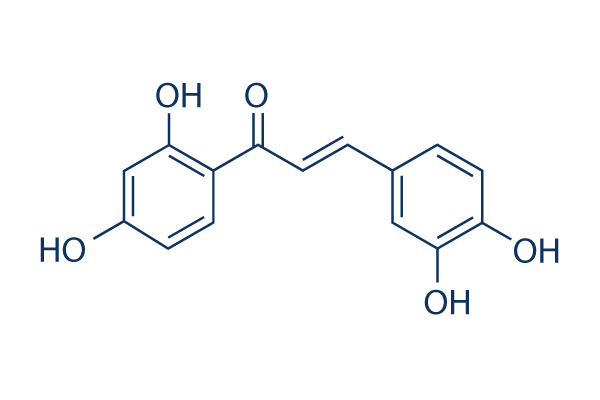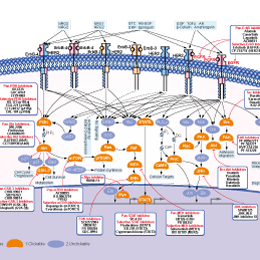
- Bioactive Compounds
- By Signaling Pathways
- PI3K/Akt/mTOR
- Epigenetics
- Methylation
- Immunology & Inflammation
- Protein Tyrosine Kinase
- Angiogenesis
- Apoptosis
- Autophagy
- ER stress & UPR
- JAK/STAT
- MAPK
- Cytoskeletal Signaling
- Cell Cycle
- TGF-beta/Smad
- DNA Damage/DNA Repair
- Compound Libraries
- Popular Compound Libraries
- Customize Library
- Clinical and FDA-approved Related
- Bioactive Compound Libraries
- Inhibitor Related
- Natural Product Related
- Metabolism Related
- Cell Death Related
- By Signaling Pathway
- By Disease
- Anti-infection and Antiviral Related
- Neuronal and Immunology Related
- Fragment and Covalent Related
- FDA-approved Drug Library
- FDA-approved & Passed Phase I Drug Library
- Preclinical/Clinical Compound Library
- Bioactive Compound Library-I
- Bioactive Compound Library-Ⅱ
- Kinase Inhibitor Library
- Express-Pick Library
- Natural Product Library
- Human Endogenous Metabolite Compound Library
- Alkaloid Compound LibraryNew
- Angiogenesis Related compound Library
- Anti-Aging Compound Library
- Anti-alzheimer Disease Compound Library
- Antibiotics compound Library
- Anti-cancer Compound Library
- Anti-cancer Compound Library-Ⅱ
- Anti-cancer Metabolism Compound Library
- Anti-Cardiovascular Disease Compound Library
- Anti-diabetic Compound Library
- Anti-infection Compound Library
- Antioxidant Compound Library
- Anti-parasitic Compound Library
- Antiviral Compound Library
- Apoptosis Compound Library
- Autophagy Compound Library
- Calcium Channel Blocker LibraryNew
- Cambridge Cancer Compound Library
- Carbohydrate Metabolism Compound LibraryNew
- Cell Cycle compound library
- CNS-Penetrant Compound Library
- Covalent Inhibitor Library
- Cytokine Inhibitor LibraryNew
- Cytoskeletal Signaling Pathway Compound Library
- DNA Damage/DNA Repair compound Library
- Drug-like Compound Library
- Endoplasmic Reticulum Stress Compound Library
- Epigenetics Compound Library
- Exosome Secretion Related Compound LibraryNew
- FDA-approved Anticancer Drug LibraryNew
- Ferroptosis Compound Library
- Flavonoid Compound Library
- Fragment Library
- Glutamine Metabolism Compound Library
- Glycolysis Compound Library
- GPCR Compound Library
- Gut Microbial Metabolite Library
- HIF-1 Signaling Pathway Compound Library
- Highly Selective Inhibitor Library
- Histone modification compound library
- HTS Library for Drug Discovery
- Human Hormone Related Compound LibraryNew
- Human Transcription Factor Compound LibraryNew
- Immunology/Inflammation Compound Library
- Inhibitor Library
- Ion Channel Ligand Library
- JAK/STAT compound library
- Lipid Metabolism Compound LibraryNew
- Macrocyclic Compound Library
- MAPK Inhibitor Library
- Medicine Food Homology Compound Library
- Metabolism Compound Library
- Methylation Compound Library
- Mouse Metabolite Compound LibraryNew
- Natural Organic Compound Library
- Neuronal Signaling Compound Library
- NF-κB Signaling Compound Library
- Nucleoside Analogue Library
- Obesity Compound Library
- Oxidative Stress Compound LibraryNew
- Plant Extract Library
- Phenotypic Screening Library
- PI3K/Akt Inhibitor Library
- Protease Inhibitor Library
- Protein-protein Interaction Inhibitor Library
- Pyroptosis Compound Library
- Small Molecule Immuno-Oncology Compound Library
- Mitochondria-Targeted Compound LibraryNew
- Stem Cell Differentiation Compound LibraryNew
- Stem Cell Signaling Compound Library
- Natural Phenol Compound LibraryNew
- Natural Terpenoid Compound LibraryNew
- TGF-beta/Smad compound library
- Traditional Chinese Medicine Library
- Tyrosine Kinase Inhibitor Library
- Ubiquitination Compound Library
-
Cherry Picking
You can personalize your library with chemicals from within Selleck's inventory. Build the right library for your research endeavors by choosing from compounds in all of our available libraries.
Please contact us at info@selleckchem.com to customize your library.
You could select:
- Antibodies
- Bioreagents
- qPCR
- 2x SYBR Green qPCR Master Mix
- 2x SYBR Green qPCR Master Mix(Low ROX)
- 2x SYBR Green qPCR Master Mix(High ROX)
- Protein Assay
- Protein A/G Magnetic Beads for IP
- Anti-Flag magnetic beads
- Anti-Flag Affinity Gel
- Anti-Myc magnetic beads
- Anti-HA magnetic beads
- Poly DYKDDDDK Tag Peptide lyophilized powder
- Protease Inhibitor Cocktail
- Protease Inhibitor Cocktail (EDTA-Free, 100X in DMSO)
- Phosphatase Inhibitor Cocktail (2 Tubes, 100X)
- Cell Biology
- Cell Counting Kit-8 (CCK-8)
- Animal Experiment
- Mouse Direct PCR Kit (For Genotyping)
- New Products
- Contact Us
research use only
Butein EGFR inhibitor
Butein, a plant polyphenol isolated from Rhus verniciflua, is able to inhibit the activation of protein tyrosine kinase, NF-κB and STAT3, and also inhibits EGFR.

Chemical Structure
Molecular Weight: 272.25
Purity & Quality Control
Batch:
S803601
DMSO]55 mg/mL]false]Ethanol]55 mg/mL]false]Water]Insoluble]false
Purity:
99.98%
99.98
Related Products
| Related Targets | EGFR/ErbB1 HER2/ErbB2 ErbB3 ErbB4 mutant EGFR | Click to Expand |
|---|---|---|
| Related Products | AG-490 AG-1478 Canertinib (CI-1033) Rociletinib (CO-1686) WZ4002 Genistein Poziotinib PD153035 PD153035 HCl Allitinib tosylate AEE788 (NVP-AEE788) Pelitinib (EKB-569) Canertinib dihydrochloride Varlitinib Icotinib (BPI-2009H) Nazartinib (EGF816) NSC228155 PD168393 Olmutinib (BI 1482694) Zorifertinib (AZD3759) | Click to Expand |
| Related Compound Libraries | Kinase Inhibitor Library Tyrosine Kinase Inhibitor Library PI3K/Akt Inhibitor Library Cell Cycle compound library Angiogenesis Related compound Library | Click to Expand |
Signaling Pathway
Mechanism of Action
| Targets |
|
|---|
In vitro |
||||
| In vitro | Butein inhibits the epidermal growth factor (EGF)-stimulated auto-phosphotyrosine level of EGF receptor in HepG2 cells, and also inhibits tyrosine-specific protein kinase activities of EGF receptor and p60c-src with IC50 of 65 μM in vitro. The inhibition is competitive to ATP and non-competitive to the phosphate acceptor, poly (Glu, Ala, Tyr) 6:3:1 for EGF receptor tyrosine kinase. In contrast, this compound non-significantly inhibits the activities of serine- and threonine-specific protein kinases such as PKC or PKA. [1] This chemical inhibits Nuclear Factor(NF)-κB and NF-κB-regulated gene expression through direct inhibition of IκBα Kinase β on Cysteine 179 Residue. [2] It (10 μM) inhibits over 90% iNOS and COX-2 expression, as well as nitrite and TNF-α production in LPS-stimulated RAW 264.7 cells. This compound (10 μM) inhibits LPS-induced DNA binding activity of NF-κB, which is mediated through inhibition of the degradation of inhibitory factor-κB and phosphorylation of Erk1/2 MAP kinase, as well as increases binding of the osteopontin a vb3 integrin receptor. [3] It (20 μM) treatment induces morphologic changes of bladder cancer cells BLS(M) from elongated morphology to rounded epithelial-like cells, accompanied by downregulation of vimentin, and gaining of E-cadherin compared to untreated control cells, indicating the reversal of mesenchymal-like phenotype. This chemical (20 μM) suppresses motility and invasion capacity of BLS(M) cells, and reverts EMT-like phenotype induced by TNF-α, through the ERK1/2 and NF-κB signaling pathways. [4] It inhibits the constitutive activation of STAT3 in HepG2 cells in a dose-dependent manner, with maximum inhibition occurring at 50 μM, mediated through the inhibition of activation of upstream kinases c-Src and Janus-activated kinase2. This compound (50 μM) also could completely inhibit IL-6-induced STAT3 phosphorylation in SNU-387 cells. It downregulates the expression of cyclin D1, Bcl-2, Bcl-xL, survivin, and VEGF, markers of STAT3 activation. This chemical (50 μM) significantly enhance the apoptotic effects of doxorubicin from 18% to 55% and of paclitaxel from 15% to 42%. [5] It is as a powerful antioxidant against lipid and LDL peroxidation. This compound inhibits iron-induced lipid peroxidation in rat brain homogenate with an IC50 of 3.3 μM. It is as potent α-tocopherol in reducing the stable free radical diphenyl-2-picrylhydrazyl (DPPH) with IC0.2 of 9.2 μM. This chemical also inhibits the activity of xanthine oxidase with an IC50 of 5.9 μM. It scavenges the peroxyl radical derived from 2,2-azobis(2-amidinopropane) dihydrochloride (AAPH) in aqueous phase. Furthermore, this compound inhibits copper-catalyzed oxidation of human low-density lipoprotein (LDL) in a concentration-dependent manner. It is a chelator of ferrous and copper ions. [6] | |||
|---|---|---|---|---|
| Cell Research | Cell lines | Human hepatoma cells HepG2 | ||
| Concentrations | ~50 μM | |||
| Incubation Time | 1 days | |||
| Method | The cells (5× 103/mL) are incubated in triplicate in a 96-well plate in the presence or absence of indicated concentration of Butein in a final volume of 0.2 mL for different time intervals at 37 ℃. Thereafter, 20 μL MTT solution (5 mg/mL in PBS) is added to each well. After a 2-hour incubation at 37 ℃, 0.1 mL lysis buffer (20% SDS, 50% dimethylformamide) is added, incubation is continued overnight at 37 ℃, and then the optical density at 570 nm is measured by plate reader. | |||
In Vivo |
||
| In vivo | Butein at 2 mg/kg induces significant inhibition of hepatocellular tumor growth compared with the corn oil-treated controls. At necropsy on day 22 after initial treatment, there is more than 2-fold decrease in tumor growth in this compound-treated group (mean relativetumor burden, 3.90) compared with the control group (8.46), associated with reduced constitutive p-STAT3 (9% vs 81% of vehicle group), Bcl-2 levels (26% vs 96% of vehicle group), and increased caspase-3 level (98% vs 21% of vehicle group) in HCC tumor tissues. [5] This compound shows antifibrogenic activity. It (25 mg/kg/day) reduces serum AST and ALT activation to 35% and 69%, respectively, of control CCl4-induced rat levels. This chemical (25 mg/kg/day) reduces liver hydroxyproline contents and TBAR4 concentration to 54% and 54%, respectively. α1(I) collagen and TIMP-1 expression in this compound-treated rats is 28% and 20.3% compared with the values for the respective CCl4-treated control. [7] | |
|---|---|---|
| Animal Research | Animal Models | Human hepatocellular carcinoma xenografts HepG2 |
| Dosages | 2 mg/kg | |
| Administration | intraperitoneal injection, 5 doses per week for 3 consecutive weeks | |
References |
|
Chemical Information
| Molecular Weight | 272.25 | Formula | C15H12O5 |
| CAS No. | 487-52-5 | SDF | Download SDF |
| Synonyms | N/A | ||
| Smiles | C1=CC(=C(C=C1C=CC(=O)C2=C(C=C(C=C2)O)O)O)O | ||
Storage and Stability
| Storage (From the date of receipt) | |||
|
In vitro |
DMSO : 55 mg/mL ( (202.02 mM) Moisture-absorbing DMSO reduces solubility. Please use fresh DMSO.) Ethanol : 55 mg/mL Water : Insoluble |
Molecular Weight Calculator |
|
In vivo Add solvents to the product individually and in order. |
In vivo Formulation Calculator |
|||||
Preparing Stock Solutions
Molarity Calculator
In vivo Formulation Calculator (Clear solution)
Step 1: Enter information below (Recommended: An additional animal making an allowance for loss during the experiment)
mg/kg
g
μL
Step 2: Enter the in vivo formulation (This is only the calculator, not formulation. Please contact us first if there is no in vivo formulation at the solubility Section.)
% DMSO
%
% Tween 80
% ddH2O
%DMSO
%
Calculation results:
Working concentration: mg/ml;
Method for preparing DMSO master liquid: mg drug pre-dissolved in μL DMSO ( Master liquid concentration mg/mL, Please contact us first if the concentration exceeds the DMSO solubility of the batch of drug. )
Method for preparing in vivo formulation: Take μL DMSO master liquid, next addμL PEG300, mix and clarify, next addμL Tween 80, mix and clarify, next add μL ddH2O, mix and clarify.
Method for preparing in vivo formulation: Take μL DMSO master liquid, next add μL Corn oil, mix and clarify.
Note: 1. Please make sure the liquid is clear before adding the next solvent.
2. Be sure to add the solvent(s) in order. You must ensure that the solution obtained, in the previous addition, is a clear solution before proceeding to add the next solvent. Physical methods such
as vortex, ultrasound or hot water bath can be used to aid dissolving.
Tech Support
Answers to questions you may have can be found in the inhibitor handling instructions. Topics include how to prepare stock solutions, how to store inhibitors, and issues that need special attention for cell-based assays and animal experiments.
Tel: +1-832-582-8158 Ext:3
If you have any other enquiries, please leave a message.
* Indicates a Required Field






































